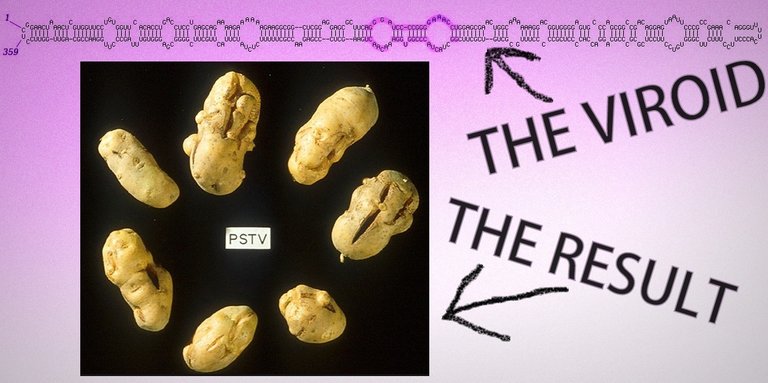Viroids are the smallest infectious pathogens known that are so small they are basically a single molecule, practically bridging the gap between chemistry and biology.

Viroids are indeed so small and simple that viruses seem kind of complex compared to them. Both viroids and viruses are basic organic structures that can't really be called living, but which share some of life's important traits - the ability to replicate themselves and the ability to adapt and evolve. Both viruses and viroids use host organisms to allow them to reproduce and as their host species change, they change with them in order to keep existing. They can also evolve in ways to allow them to infect new host species.
The difference between viruses and viroids
Viruses, which are much more common and a bit more complex are still pretty simple. They are a piece of genetic material encased in a protein shell. They reproduce by entering a cell and hijacking it so it starts producing copies of the virus instead of functioning normally. This means that the genetic code inside the virus also codes for the proteins that make up its shell. It's a simple but effective approach that allows viruses to spread, mutate and adapt to new hosts and has proven to be a successful self-replication or survival strategy (whatever you'd rather call it).
On the other hand, viroids are even smalled and simpler and each one is just a single-stranded RNA molecule that is looped in a circular manner. They don't have a shell and all they are is a piece of genetic material that has the ability to replicate itself inside host cells. What the host provides them with is the RNA polymerase II enzyme and mRNA which are used to copy the genetic template that is the viroid itself into a new copy. The new copies can in turn spread to new host cells repeating the process over and over again. Viroids usually spread by mechanical contact or through insects that can carry them host to host.
What do viroids infect?
All the known viroids affect plants. The first one to be discovered was the potato spindle tuber viroid which in turn causes the potato spindle tuber disease. There are different viroids that affect avocados, cucumbers, coconuts, tomatoes and others. Viroids that affect non-plant hosts have not been found yet, but aren't theoretically impossible.

Why are they so interesting?
The fact that viroids are so simple and yet still viable shows us how simple and unassuming proto-life could have been as part of the process of abiogenesis. They might be quite useful in providing the mechanism by which organic molecules could have started to replicate themselves in a pre-cellular RNA world as proposed by the RNA world hypothesis. It talks about a hypothetical phase of the evolution of life on Earth in which self-replicating RNA molecules might have become abundant due to self-replication before the emergence of more complex organic compounds required for life as we know it like DNA and proteins.
Viroids are very good candidates for the type of RNA that could have become abundant in such an environment because they have a few interesting qualities. They are small and stable and their circular shape allows for complete replication without the need for genomic tags. Additionally, they don't code for proteins, so they could have started to function without the presence of ribosomes. If this hypothesis turns out to be correct, viroids might turn out to be "living relics" of that long-gone pre-cellular RNA world that led to the special conditions that ignited the spark of life.